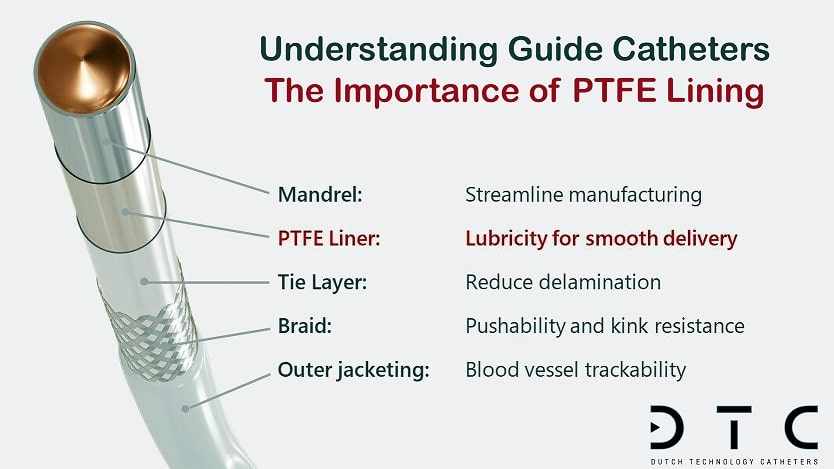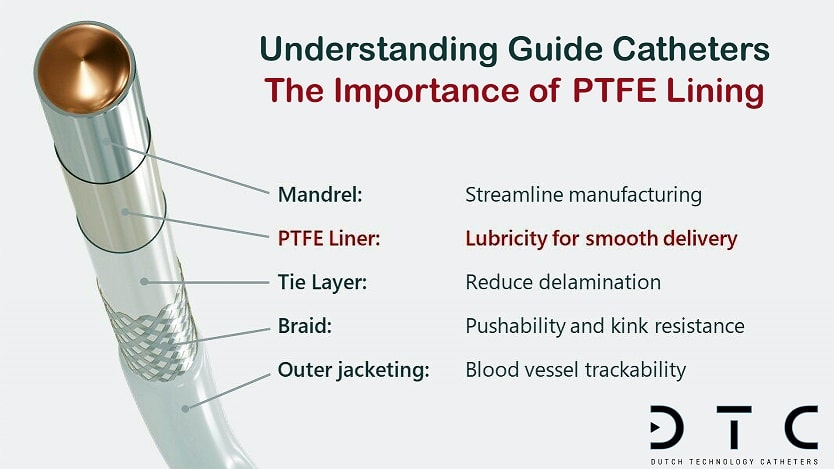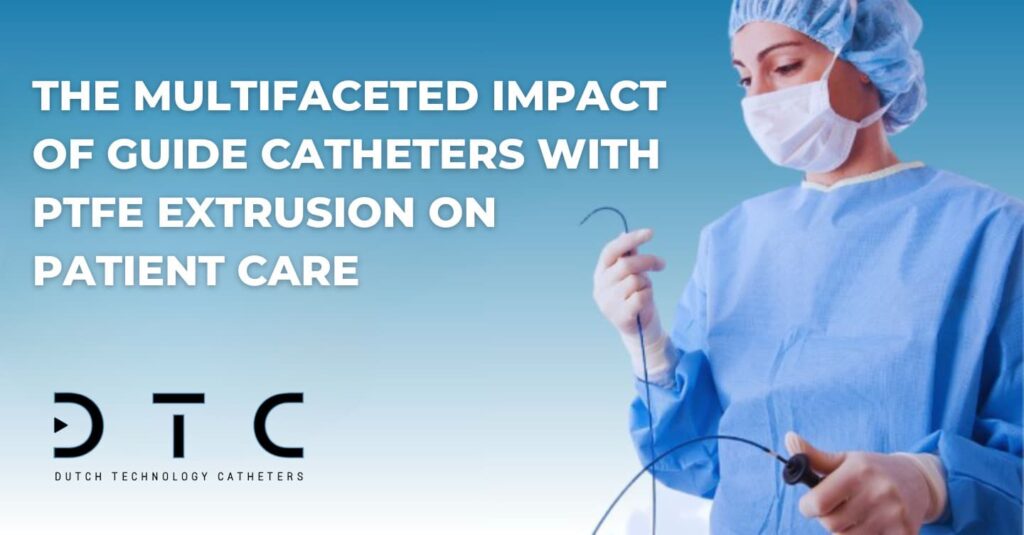
The use of catheters is essential in medical procedures. The guiding catheter with PTFE lining pipe has become a key instrument in the healthcare sector among numerous forms. This blog article seeks to clarify the significance and advantages of these catheters while primarily emphasizing their PTFE lining.

What is a Guide Catheter: A Comprehensive Outlook
A guide catheter is an essential medical tool, particularly in interventional treatments. It is a type of medical tubing designed to let tiny medical equipment or instruments reach particular parts of the body. Guide catheters are often comprised of flexible materials that can travel the various channels of the body. The catheter’s suppleness enables it to follow the twists and turns of the body’s circulatory system without causing harm or discomfort to the patient.
Application of Guiding Catheters in Medical Procedures
A guide catheter’s principal function is to ease the transportation of other medical devices to the appropriate area within the body. Stents, balloons, and other tools used in diagnostic or therapeutic treatments are examples of these devices. A balloon guide catheter, for example, might be used to convey a balloon to the location of a blocked artery during a treatment to treat it.
Guide catheters can also be used to administer contrast agents or drugs to particular areas of the body. This enables tailored treatment, which has the potential to be more successful and have fewer negative effects than systemic treatment.
Variations in Designs of Guide Catheter
Guide catheters are available in a variety of diameters and forms to accommodate varied treatments and anatomical needs. Some guide catheters have curved tips to reach specific parts of the heart, while others have straight tips for more direct paths.
The Advantages of PTFE Lining in Guide Catheters
Enhanced Performance
PTFE catheter liner, also known as Polytetrafluoroethylene tubing, is a high-performance polymer coat that improves the function of guiding catheters. Its low friction coefficient makes it a perfect material for catheter linings, allowing other medical equipment to move through the catheter smoothly. This smooth passage is especially critical for difficult operations that include the insertion of equipment into delicate bodily components.
Increased Safety
Due to its exceptional chemical resistance, PTFE catheter liners do not react with human fluids or drugs. Because of its feature, it is suitable for usage in the human body. Furthermore, Polytetrafluoroethylene tubing has better temperature resistance, which is critical for heat-generating activities.
Durability and Flexibility
The PTFE lining’s durability and flexibility also contribute to its potential for use in guide catheters. These characteristics enable the catheter to navigate the human body’s intricate pathways without causing harm or discomfort.
Guiding Catheter Types with PTFE Catheter Liner
Guide catheters come in a variety of types, each designed for specific applications. Here are a few common types:
Over the Wire Catheters
These catheters are used in procedures where precise placement is necessary. They are guided into place using a guidewire.
Balloon Guide Catheter
These catheters have a small inflatable balloon at the tip, which can be used to widen narrow or blocked arteries.
Exchange Length Catheters
These are longer catheters used in complex procedures where standard-length catheters may not reach the desired location.
Each type of guide catheter has its own benefits and is chosen depending on the medical procedure’s unique requirements.
The Manufacturing Process of PTFE Lined Catheters
Material Selection
The production process of PTFE extruded guide catheters begins with the selection of high-quality PTFE. This material was chosen for its distinctive features, which include reduced friction, chemical resistance, and temperature resistance.
Extrusion Process
The PTFE is then heated and pressed through a die to form a tube during the extrusion process. This tube creates the catheter’s lining, resulting in PTFE tubing.
Assembly
After that, the PTFE extruded tubing is put into the catheter body, which is usually constructed of another flexible material. To guarantee that the lining fits exactly within the catheter body, the assembling procedure must be precise.
Quality Control
After the guide catheter is built, it is subjected to stringent quality control examinations. These tests confirm that the catheter complies with all applicable medical requirements and that the PTFE lining is properly installed and free of flaws.
The Multifaceted Impact of Guide Catheters with PTFE Extrusion on Patient Care
Enhanced Effectiveness of Medical Procedures
The use of PTFE lined catheters has greatly increased the efficacy of several medical operations. Because of the low friction qualities of PTFE, medical equipment may move more smoothly and precisely within the body. This accuracy helps to the procedure’s overall success, whether it entails the installation of a stent, the administration of medicine, or the conduct of a diagnostic test.
Safety and Infection Control
In every medical procedure, safety is of the utmost importance. In numerous ways, PTFE-lined catheters improve patient safety. For starters, the chemical resistance of PTFE decreases the possibility of interactions between the catheter and physiological fluids or drugs. This can reduce the possibility of problems during and after treatments. Second, because PTFE-lined catheters have a smooth surface, they are less prone to cause tissue injury, lowering the risk of infection.
Improved Patient Comfort
Catheters can be painful for people during medical operations. The use of PTFE-lined catheters, on the other hand, can greatly increase patient comfort. The PTFE lining’s smooth surface lowers friction, allowing medical equipment to move more freely within the body. This can lessen discomfort during the surgery and hasten recovery.
Positive Impact on Overall Patient Outcomes
The combined advantages of guide catheters with PTFE extrusion-greater procedural efficacy, higher safety, and increased patient comfort-all lead to improved overall patient outcomes. Patients might expect shorter hospital stays, fewer problems, and speedier recovery periods. This not only benefits patients but also lessens the cost of healthcare systems.

Future Prospects of Guide Catheters with PTFE Lining
Technological Advancements
The design and utility of PTFE lined catheters improve as technology develops. Researchers are always looking for new ways to improve these gadgets, whether it’s by enhancing the properties of PTFE, devising new manufacturing techniques, or adding smart technologies. Integration of sensor technology, for example, might allow for real-time monitoring of the catheter’s placement as well as the patient’s physiological responses, resulting in more precise and effective procedures.
Expanding Applications
While PTFE lined catheters are now used in a range of medical procedures, their applications are growing as we learn more about them. They might be used in more complex or less intrusive therapies or in new sectors of medicine that are now being researched.
Regulatory Considerations
The use of PTFE-lined catheters will grow, as will the need for regulatory oversight. Regulatory agencies all across the world will need to ensure that these gadgets meet the highest safety and effectiveness standards. This might entail developing new testing methods, establishing production standards, or developing guidelines for their use in clinical settings.
The Role of PTFE Lined Catheters in Healthcare Economics
Cost Effectiveness
Because of their improved efficacy and longevity, guide catheters with PTFE catheter liners can be more cost-effective than regular catheters. Their capacity to prevent complications and enhance patient outcomes has the potential to save healthcare systems money.
Market Growth
The PTFE catheter market is likely to rise in the future years, driven by rising demand, technical advances, and expanded applications. This expansion may create new business prospects and career opportunities in the medical device industry.
Environmental Impact of PTFE Lined Catheters
Waste Management
PTFE-lined catheters, like other medical equipment, create waste. However, the chemical resistance and durability of PTFE, which makes it so helpful in medical applications, also make it difficult to dispose of in an environmentally acceptable manner. To reduce the environmental effect of these gadgets, healthcare institutions must implement suitable waste management processes.
Recycling and Reuse
While recycling PTFE can be difficult, research into more effective techniques for recycling this material is being done. These solutions, if effective, might assist in lessening the environmental impact of PTFElined catheters. Furthermore, certain catheters may be recycled and reused, which can assist in decreasing waste.
Sustainable Alternatives
More sustainable alternatives to PTFE for use in catheters are also being researched. While these alternatives are still in the early phases of research, they may one day provide a more ecologically friendly choice.
Conclusion: The Transformative Role of PTFE Lined Catheters
Guide catheters with PTFE lining have transformed medical tubing and interventional medicine. Their distinct features have made them an important tool in a wide range of medical operations, improving patient outcomes, boosting safety, and increasing treatment efficacy.
The future of PTFE-lined catheters is bright, with continued research and technical improvements projected to improve their design and functioning. However, it is equally critical to examine the environmental effect of these gadgets and aim for more sustainable manufacturing and disposal processes.
We should expect even bigger gains in patient care and healthcare outcomes as we continue to study and exploit the potential of guide catheters with PTFE lining.
Frequently Asked Questions
1. Why are catheters lined with PTFE?
Catheters are often lined with PTFE (Polytetrafluoroethylene) due to its unique properties. The low friction coefficient of PTFE makes catheter insertion and mobility inside the body more easier for the patient. It also has high chemical resistance, which means it won’t react with bodily fluids or pharmaceuticals, making it safe for usage in humans.
2. What are the applications of PTFE catheters?
PTFE catheters are utilized in a wide range of medical procedures, including angioplasty, stent implantation, endoscopy, and others. Their smooth surface lets other medical instruments pass through easily, making these treatments more comfortable for the patient and more efficient for the healthcare professional.
3. Is it safe to use PTFE liners in catheters?
Yes, PTFE liners in catheters are safe to use. PTFE is a biocompatible substance, which means it may be used in the human body. It does not react with bodily fluids or drugs, which reduces the possibility of consequences. Furthermore, its low friction surface helps prevent tissue injury, improving patient safety even further.
4. Can PTFE catheters be recycled or reused?
Because of its chemical resistance, recycling PTFE can be difficult. However, research into more effective techniques for recycling this material is being done. Some catheters can be reprocessed and reused, although this is dependent on the individual kind of catheter and the restrictions in place at each healthcare facility.
